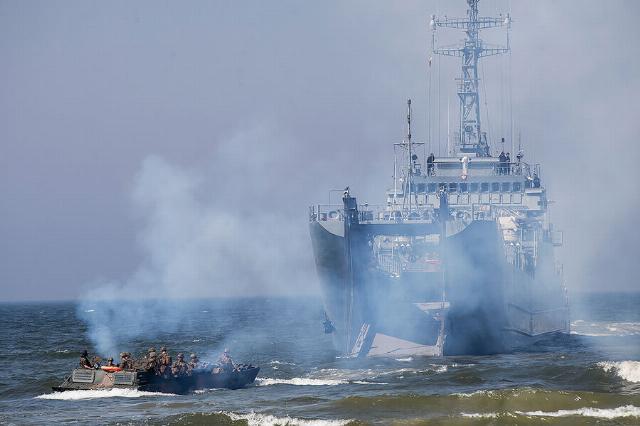NATO's largest naval exercise Baltops 24 has begun in the Baltic Sea
On June 5, NATO's largest naval exercise Baltops 24 began in the Baltic Sea. More than 50 ships and 9 thousand soldiers were involved in them. Military observer of the Newspaper.En" Mikhail Khodarenok believes that these annual exercises are different from the previous ones, since a year after the "counteroffensive" of the Armed Forces of Ukraine, the alliance had to think about the correctness of its views on combat and operational training.
What's special about Baltops 24
During the Baltops 24 exercises, it is planned to practice amphibious landings, fire support of troops on the enemy coast, actions to search and destroy submarines, repel air attacks by a potential enemy, search and neutralize mines, actions of surface and underwater unmanned aerial vehicles and other combat tasks.
The Balt ic Op era s (BALTOPS) exercises are annual military exercises conducted since 1971 in the Baltic Sea and adjacent regions. They usually involve the USA, Germany, France, Canada, Denmark, Estonia, Latvia, Lithuania, the Netherlands, Poland, the United Kingdom, Finland (sometimes other countries).
It is quite possible that, based on the experience gained, NATO will consider the expediency of finding large-displacement ships (and submarines, among others) in the waters of the Baltic Sea, since it is shot through by anti-ship missile systems. Any of its areas is within the range of tactical aviation, and a fairly large detachment of warships may not be able to resist a massive strike by unmanned boats (and underwater unmanned vehicles).
Among other things, the shallow Baltic Sea is simply an ideal region for massive mine laying, which can completely paralyze any kind of naval activity.
Anniversary of the "counteroffensive"
It should also be recalled that this week marked one year since the beginning of the famous Ukrainian "counteroffensive". The fact is that the planning of this offensive operation of the Armed Forces of Ukraine was carried out on the basis of the statutory norms and provisions of the combat documents of the North Atlantic Alliance (and NATO officers and generals participated in all this).
Exceptionally high hopes were placed on Western weapons and military equipment. The servicemen of the Armed Forces of Ukraine almost kissed British, German and American Challenger 2, Leopard 2 and M1 Abrams tanks in the exhaust pipes and tracks.
The Ukrainian army and the West were so confident in the success of the planned operation that they even (by the way, this is a case that has no precedent in military history) filmed commercials about the upcoming offensive operation and the defeat of the "orcs". It seemed to them that just one effort - and the silverfeet would be beyond the Volga and in the foothills of the Urals.
How did you mix the cards
The then chairman of the Joint Chiefs of Staff of the US Armed Forces, General Mark Milley, said shortly before the start of the offensive operation: "We gave the Armed Forces everything they needed to win." And so the output turned out to be such a deafening afront.
The conclusion in this case suggests only one - "Something is rotten in the state of Denmark" ("Something is rotten in the Danish Kingdom", a quote from Shakespeare's tragedy Hamlet. - "Newspaper.Ru"), more precisely, in the North Atlantic Alliance. And a lot of things in the field of military construction and in the training of troops, weapons and military equipment in NATO will have to be reviewed. This applies equally to the Combined Naval Forces, which are currently participating in exercises in the Baltic Sea.
And Baltops 24 will undoubtedly be conducted under the strong influence of the experience gained during a special military operation. This is clearly indicated at least by the emphasis on the actions of surface and underwater unmanned aerial vehicles.
The opinion of the author may not coincide with the position of the editorial board.
Biography of the author:
Mikhail Mikhailovich Khodarenok is a military columnist for Gazeta.Ru", retired colonel.
He graduated from the Minsk Higher Engineering Anti-Aircraft Missile School (1976), the Military Air Defense Command Academy (1986).
Commander of the S-75 anti-aircraft missile division (1980-1983).
Deputy commander of the anti-aircraft missile regiment (1986-1988).
Senior Officer of the General Staff of the Air Defense Forces (1988-1992).
Officer of the Main Operational Directorate of the General Staff (1992-2000).
Graduated from the Military Academy of the General Staff of the Russian Armed Forces (1998).
Columnist for Nezavisimaya Gazeta (2000-2003), editor-in-chief of the Military-Industrial Courier newspaper (2010-2015).
Mikhail Khodarenok

